|
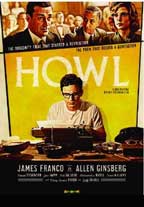
Howl
Oscilloscope
Laboratories,
2010
Director/Screenplay
Rob Epstein,
Jeffrey Friedman
Starring:
James Franco,
Mary-Louise Parker
Jon Hamm,
Jeff Daniels,
David Strathairn,
Treat Williams,
Bob Balaban,
Alessandro Nivola,
Aaron Tveit
Jon Prescott,
Todd Rotondi,
Allen Ginsberg (archival)
Rated
R, 84 minutes
|
Angelheaded
Hipsters
by
Michael D. Klemm
Posted online March, 2011
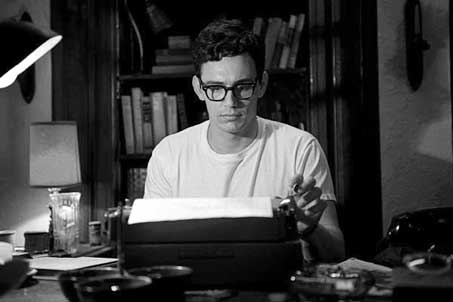
Howl
is one of the most celebrated (some might say notorious) poems of the
20th Century. Setting the stage for the Beat Generation writers, Howl
was their first major published work, pre-dating even Jack Kerouac's seminal
On The Road. Written in 1955 by Allen Ginsberg, Howl pushed
a lot of envelopes and a lot of buttons. Ginsberg was one third
of the trinity of authors always associated with the Beats, the other
two being Kerouac and William S. Burroughs (Naked Lunch, Junky, Queer).
Ginsberg was openly gay and so were many passages in Howl. This
offended more than a few delicate sensibilities and the poem was declared
obscene. Many works of art went on trial during the last century and Howl's
victory in court opened doors of free speech that reverberate to this
day.
|
|
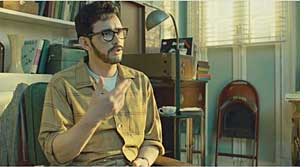 Howl,
the 2010 film, was co-written and directed by Rob Epstein and Jeffrey
Friedman. They are the team responsible for Common Threads: Stories
From The Quilt (1989), The
Celluloid Closet (1995) and Paragraph 175 in 2000. (Epstein,
alone, also directed The Times Of Harvey Milk in 1984.) Known primarily
as documentary filmmakers, their approach to Howl
is very interesting. On one level the film could be called documentary
because none of the spoken words were written by the filmmakers. They
come from the court transcripts, from an interview given by Ginsberg during
the trial, from letters and, lastly, the words of the poem itself. Howl,
the 2010 film, was co-written and directed by Rob Epstein and Jeffrey
Friedman. They are the team responsible for Common Threads: Stories
From The Quilt (1989), The
Celluloid Closet (1995) and Paragraph 175 in 2000. (Epstein,
alone, also directed The Times Of Harvey Milk in 1984.) Known primarily
as documentary filmmakers, their approach to Howl
is very interesting. On one level the film could be called documentary
because none of the spoken words were written by the filmmakers. They
come from the court transcripts, from an interview given by Ginsberg during
the trial, from letters and, lastly, the words of the poem itself.
|
|
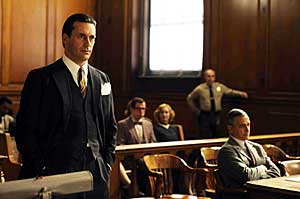 It
is the way these words are presented that make watching Howl
a pure pleasure. We are guests at the first reading of Howl in
a small, smoke-filled coffeehouse in San Francisco. We are in Allen Ginsberg's
apartment as he lights one cigarette after another and riffs about his
art to an unseen interviewer. Then we are in a courtroom as Howl goes
on trial and expert witnesses either praise or dismiss the offending poem.
These three stories intertwine and shuffle back and forth to form a compelling
narrative. Dates and names are supplied to aid the viewer. Ginsberg's
recitation of Howl is filmed in black & white, as are several silent
flashbacks, the rest is in color. Augmenting the readings of Howl
are some very effective animated sequences that bring the images of Ginsberg's
"angelheaded hipsters" to life. It
is the way these words are presented that make watching Howl
a pure pleasure. We are guests at the first reading of Howl in
a small, smoke-filled coffeehouse in San Francisco. We are in Allen Ginsberg's
apartment as he lights one cigarette after another and riffs about his
art to an unseen interviewer. Then we are in a courtroom as Howl goes
on trial and expert witnesses either praise or dismiss the offending poem.
These three stories intertwine and shuffle back and forth to form a compelling
narrative. Dates and names are supplied to aid the viewer. Ginsberg's
recitation of Howl is filmed in black & white, as are several silent
flashbacks, the rest is in color. Augmenting the readings of Howl
are some very effective animated sequences that bring the images of Ginsberg's
"angelheaded hipsters" to life.
|
|
Howl
erupts with one of the most provocative, and well known, openings in literary
history:
"I
saw the best minds of my generation destroyed by madness, starving hysterical
naked,
dragging themselves through the negro streets at dawn looking for an
angry fix"
Much
of what scandalized the McCarthy-era mainstream was undoubtedly the sex
acts described in the poem - it didn't help that much (but not all) of
it had a queer bent:
"who howled on their
knees in the subway and were dragged off the roof waving genitals and
manuscripts,
who let themselves be fucked in the ass by saintly motorcyclists, and
screamed with joy,
who blew and were blown by those human seraphim, the sailors, caresses
of Atlantic and Caribbean love,
who balled in the morning in the evenings in rosegardens and the grass
of public parks and cemeteries scattering their semen freely to whomever
come who may,"
|
|
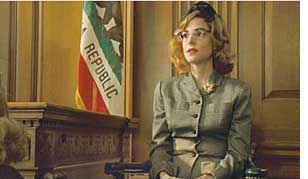 Yes,
Howl was hardly Robert Frost. The "expert witnesses" at the obscenity
trial have a lot to say about it. Mary
Louise Parker is hilarious as a prim and proper Donna Reed-clone schoolteacher
who has "rewritten Faust" (this elicits titters in the courtroom) and
proclaims Howl to be worthless because it contains no rhyme or
meter. As for its more provocative contents, she admits that she limited
her exposure to its filth for only a few minutes. Others sing the poem's
praises. Judge Clayton W. Horn (Bob
Balaban) ultimately rules in favor of Howl. He acknowledges
its "redeeming social importance" and further asks: "Would there be any
freedom of press or speech if one must reduce his vocabulary to vapid
innocuous euphemisms?" Howl opened the floodgates. Before long,
Grove Press tested the new legal precedent and Lady Chatterley's Lover
by D.H. Lawrence, and the homoerotic novels of Jean Genet, were finally
published in the United States. Not to mention Henry Miller's Tropics
of Capricorn and Cancer. Yes,
Howl was hardly Robert Frost. The "expert witnesses" at the obscenity
trial have a lot to say about it. Mary
Louise Parker is hilarious as a prim and proper Donna Reed-clone schoolteacher
who has "rewritten Faust" (this elicits titters in the courtroom) and
proclaims Howl to be worthless because it contains no rhyme or
meter. As for its more provocative contents, she admits that she limited
her exposure to its filth for only a few minutes. Others sing the poem's
praises. Judge Clayton W. Horn (Bob
Balaban) ultimately rules in favor of Howl. He acknowledges
its "redeeming social importance" and further asks: "Would there be any
freedom of press or speech if one must reduce his vocabulary to vapid
innocuous euphemisms?" Howl opened the floodgates. Before long,
Grove Press tested the new legal precedent and Lady Chatterley's Lover
by D.H. Lawrence, and the homoerotic novels of Jean Genet, were finally
published in the United States. Not to mention Henry Miller's Tropics
of Capricorn and Cancer.
|
|
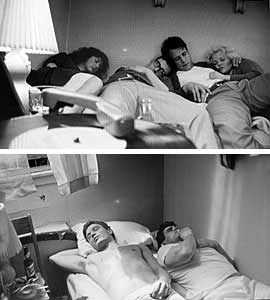 A
little more background: The lives of the Beat writers were as interesting
as their writings and the lines between them were often blurred. The Beats
embraced non-conformity during an era marked by the Communist witch hunts
and television fodder like Ozzie and Harriet and Father Knows
Best. Their writings are noted for being as spontaneous as their lives
were. The Beats took big bites out of life, inspiring a generation to
thumb their noses at authority and do the same. They were the forerunners
of the hippies in the 1960s. The Beat Generation was also surprisingly
queer. Ginsberg was openly gay, as was Burroughs, while Kerouac was one
of literature's great closet cases. Both Ginsberg and Kerouac were enraptured
by the charismatic womanizing hipster Neal Cassady, whom Kerouac immortalized
as Dean Moriarity in On The Road. Ginsberg and Cassady's relationship
sometimes entered the realm of the carnal. Kerouac never consummated the
relationship with his masculine muse but Gore Vidal relates a drunken
night of sex with Kerouac in his 1995 memoir, Palimpsest. A
little more background: The lives of the Beat writers were as interesting
as their writings and the lines between them were often blurred. The Beats
embraced non-conformity during an era marked by the Communist witch hunts
and television fodder like Ozzie and Harriet and Father Knows
Best. Their writings are noted for being as spontaneous as their lives
were. The Beats took big bites out of life, inspiring a generation to
thumb their noses at authority and do the same. They were the forerunners
of the hippies in the 1960s. The Beat Generation was also surprisingly
queer. Ginsberg was openly gay, as was Burroughs, while Kerouac was one
of literature's great closet cases. Both Ginsberg and Kerouac were enraptured
by the charismatic womanizing hipster Neal Cassady, whom Kerouac immortalized
as Dean Moriarity in On The Road. Ginsberg and Cassady's relationship
sometimes entered the realm of the carnal. Kerouac never consummated the
relationship with his masculine muse but Gore Vidal relates a drunken
night of sex with Kerouac in his 1995 memoir, Palimpsest.
|
|
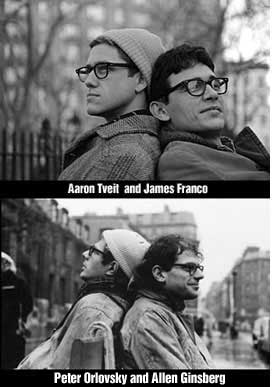 Ginsberg
is forthcoming about his homosexuality during the interview sequences.
His words provide a full portrait, including comical character contradictions.
He may bare his soul on the page but he never expected Howl to
be published and fretted about his father reading it. His poetry was one
way that he tried to secure the love of the straight men around him; if
they couldn't love him sexually perhaps they could love him for his art.
At the very least he hoped his art would make them go to bed with him;
he succeeded a few times with Neal Cassady but never with Kerouac - whom
he says he wrote Howl for. During a few wordless black and white
flashbacks we catch glimpses of Ginsberg's awkward sex life with Cassady
and also bliss with Peter Orlovski, the man who would become his life
partner. Many iconic photographs of the Beats become living tableaus in
this film; fans of their literary movement will find much to recognize
and to cherish. There is a nice contrast between these bohemian images
and the conservatively dressed Life magazine people seen in the
courtroom. Ginsberg
is forthcoming about his homosexuality during the interview sequences.
His words provide a full portrait, including comical character contradictions.
He may bare his soul on the page but he never expected Howl to
be published and fretted about his father reading it. His poetry was one
way that he tried to secure the love of the straight men around him; if
they couldn't love him sexually perhaps they could love him for his art.
At the very least he hoped his art would make them go to bed with him;
he succeeded a few times with Neal Cassady but never with Kerouac - whom
he says he wrote Howl for. During a few wordless black and white
flashbacks we catch glimpses of Ginsberg's awkward sex life with Cassady
and also bliss with Peter Orlovski, the man who would become his life
partner. Many iconic photographs of the Beats become living tableaus in
this film; fans of their literary movement will find much to recognize
and to cherish. There is a nice contrast between these bohemian images
and the conservatively dressed Life magazine people seen in the
courtroom.
|
|
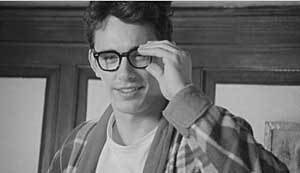 James
Franco is uncanny as Ginsberg. Franco played gay before when he was
cast as Harvey Milk's first lover in Gus
Van Sant's Milk.
The right actor in a role like this is essential and Franco delivers the
goods. He is passionate as Ginsberg; he is hip to a music that he
hears and he projects that persona without it becoming a cliche. He reads
the words of Howl with authority, giving the viewer a sense of
just how it inspired a restless generation. A who's who of fine character
actors populate the courtroom segments, including David Strathairn and
Mad Men's Jon Hamm as the prosecuting and defense lawyers, and
Jeff Daniels and Treat Williams as witnesses. James
Franco is uncanny as Ginsberg. Franco played gay before when he was
cast as Harvey Milk's first lover in Gus
Van Sant's Milk.
The right actor in a role like this is essential and Franco delivers the
goods. He is passionate as Ginsberg; he is hip to a music that he
hears and he projects that persona without it becoming a cliche. He reads
the words of Howl with authority, giving the viewer a sense of
just how it inspired a restless generation. A who's who of fine character
actors populate the courtroom segments, including David Strathairn and
Mad Men's Jon Hamm as the prosecuting and defense lawyers, and
Jeff Daniels and Treat Williams as witnesses.
|
|
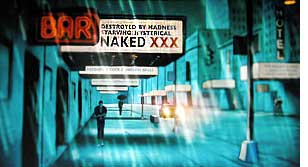 The
animation is an interesting mix of Gerald Scharf's work in Pink Floyd
The Wall and the "Night on Bald Mountain" sequence of Disney's Fantasia
with its eerie swooping ghosts leaving trails through the night sky. It
is often quite inventive, subway trains predominate, piles of old books
become skyscrapers. A saxophone player's instrument shoots sparks in the
sky, the keys of both a piano and a typewriter convey visually the jazz
rhythms that so informed these writers' works. I especially liked the
words of Howl on the typewriter transforming into musical notes.
The use of phallic imagery rivals even Fassbinder's Querelle.
Was the animation necessary? Perhaps not, but it adds a unique visual
dimension and creates its own brand of poetry for a new generation weaned
on graphic novels. The
animation is an interesting mix of Gerald Scharf's work in Pink Floyd
The Wall and the "Night on Bald Mountain" sequence of Disney's Fantasia
with its eerie swooping ghosts leaving trails through the night sky. It
is often quite inventive, subway trains predominate, piles of old books
become skyscrapers. A saxophone player's instrument shoots sparks in the
sky, the keys of both a piano and a typewriter convey visually the jazz
rhythms that so informed these writers' works. I especially liked the
words of Howl on the typewriter transforming into musical notes.
The use of phallic imagery rivals even Fassbinder's Querelle.
Was the animation necessary? Perhaps not, but it adds a unique visual
dimension and creates its own brand of poetry for a new generation weaned
on graphic novels.
|
|
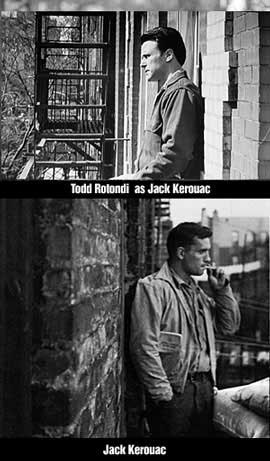 As
mentioned earlier, re-creating several iconic photos of the Beats was
a good idea and it adds legitimacy to the enterprise. Kerouac famously
described the first reading of Howl in his novel, The Dharma
Bums; those who have read it willl recognize the jugs of wine being
passed around the audience in the film. You know that the filmmakers at
least did their research. The understated be-bop jazz score is effective.
The cinematography evokes the films from the 1950s; the contrast between
the oversatuated color in the courtroom and the hipper black & white photography
during the flashbacks beautifully illustrates the opposite poles from
that tumultuous decade. I find the film to be almost perfect. My one quibble
is the fake beard that Franco wears during the interview sequences. Luckily
his performance overshadows the phony whiskers. A reviewer in The Gay
And Lesbian Review calls Howl
a "lit-flick" and I think this is an apt description (not to mention a
film genre that I would like to see more of). As
mentioned earlier, re-creating several iconic photos of the Beats was
a good idea and it adds legitimacy to the enterprise. Kerouac famously
described the first reading of Howl in his novel, The Dharma
Bums; those who have read it willl recognize the jugs of wine being
passed around the audience in the film. You know that the filmmakers at
least did their research. The understated be-bop jazz score is effective.
The cinematography evokes the films from the 1950s; the contrast between
the oversatuated color in the courtroom and the hipper black & white photography
during the flashbacks beautifully illustrates the opposite poles from
that tumultuous decade. I find the film to be almost perfect. My one quibble
is the fake beard that Franco wears during the interview sequences. Luckily
his performance overshadows the phony whiskers. A reviewer in The Gay
And Lesbian Review calls Howl
a "lit-flick" and I think this is an apt description (not to mention a
film genre that I would like to see more of).
|
|
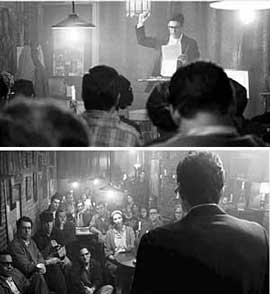 The
extras on the DVD are nirvana to a literature freak like me. I was into
the Beats big time during the late 70s in college, and so I had quite
a "naked lunch" and ate up the interviews with Ginsberg's partner, Peter
Orlovsky, and with Laurence Ferlinghetti, the owner of the legendary City
Lights Bookstore who wound up on trial for publishing Howl. There
is footage of the real Ginsberg (as an old man) reading Howl, a
good making-of doc and a commentary (that is actually interesting for
a change) by the directors and their star. A lot of love went into this
movie and it shows. It would please me to see this film embraced by the
gay community. We can admire queer icons like Ricky Martin and Lance Bass
all we want, but Allen Ginsberg was out in the 1950s when it was not
fashionable. Howl, the
movie, is quite welcome. The
extras on the DVD are nirvana to a literature freak like me. I was into
the Beats big time during the late 70s in college, and so I had quite
a "naked lunch" and ate up the interviews with Ginsberg's partner, Peter
Orlovsky, and with Laurence Ferlinghetti, the owner of the legendary City
Lights Bookstore who wound up on trial for publishing Howl. There
is footage of the real Ginsberg (as an old man) reading Howl, a
good making-of doc and a commentary (that is actually interesting for
a change) by the directors and their star. A lot of love went into this
movie and it shows. It would please me to see this film embraced by the
gay community. We can admire queer icons like Ricky Martin and Lance Bass
all we want, but Allen Ginsberg was out in the 1950s when it was not
fashionable. Howl, the
movie, is quite welcome.
More
on the Beat Writers:
Kill Your Darlings
More
on Rob Epstein and Jeffrey Friedman:
The
Celluloid Closet
James
Franco also appears in:
Milk
Mary
Louise-Parker also appears in:
Longtime
Companion
Angels in America
Bob
Balaban also appears in:
Waiting
For Guffmann
|

